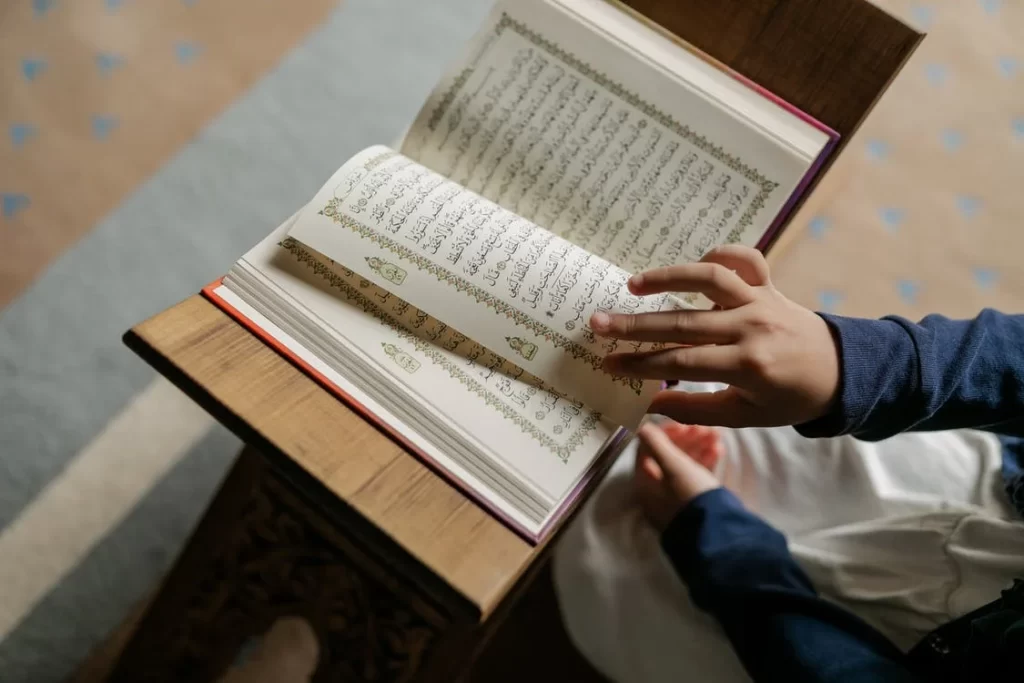Tajweed quran or the science of Tajweed in Islam is a science by which you know how to pronounce the words of the Qur’an as pronounced by the Prophet Muhammad bin Abdullah. It is taken orally from a sheikh or professor who has a license to teach Tajweed. The beginning of the science of tajweed was when the Islamic state expanded in the third century of migration, when errors and melody increased in the Qur’an due to the entry of many non-Arabs into Islam. The scholars of the Qur’an only began to write down the provisions and rules of intonation. It is said that the first person to compile the knowledge of intonation in a book was Imam Abu Obaid al-Qasim bin Salam in the third century AH in his book called the Book of Readings.
Definition of Tajweed quran
“Tajweed quran is giving the letters their rights, arrangement and ranks, returning the letter from the dictionary to its origin and origin, appending it to its counterpart and its form, satisfying its wording, and enabling its pronunciation in the state of its form and form without extravagance or arbitrariness, nor excessive or imposing, and there is no sport between intonation and leaving it, except Whoever contemplates it with its decoding” and accordingly what is meant by the science of recitation of the Qur’an idiomatically: “that it is the specialized science in how to pronounce the Qur’anic words, exiting, adjective, endowment, beginning, linking, and endowment, by giving each letter its right of the necessary attributes and its due from the adjectives of the adjectives”.
History of Tajweed quran
After God Almighty blessed the Muslims with the Islamic conquests and the area of the Islamic world expanded, the Arabic tongue mixed with the non-Arab, and the rulers of the Muslims feared the spread of melody and error in the pronunciation of the verses of the Noble Qur’an. The credit goes to controlling the provisions of the science of intonation and putting it to the imams of reading and language, and the first to put it was Al-Khalil bin Ahmed Al-Farahidi, and some of them attributed it to Abu Al-Aswad Al-Du’ali and it was said: Abu Obaid Al-Qasim bin Salam, then Abu Muzahim Al-Khaqani, who died in 325 AH, created his poem Al-Ra’i of 51 verses. In the science of reciting the Qur’an, and he was the first to write about this science in the late 3rd century AH.
Pillars of reading the Holy Quran
The scholars considered the three pillars of the correct recitation related in its chain of transmission to the station of the Messenger of God – may God’s prayers and peace be upon him-, as they must be met together for the acceptance of recitation and its adoption in the science of recitation of the Qur’an, and they are according to the following – and God Almighty knows best:
The first pillar: agreeing with the reading of the Arabic language in one way: an example is the saying of the Most High in Surat Al-Baqarah: {So Adam received words from his Lord, so He repented to him}, where the word “Adam” was read with the meaning “Adam” and this is an accusative of “Adam” with the meaning of “Adam”. An aspect that agrees with the meaning and the science of grammar, and it is one of the aspects of the eloquence and eloquence of the Qur’an.
The second pillar: agreeing to the reading of the Ottoman handwriting in order to verify or appreciate: for example: the Almighty’s saying: {And God is not unaware of what you do}, where the word “you do” was read with the ta’ once, and the ya’a once, and the Qur’an reads two times. , since the Ottoman Qur’an was not dotted at that time, and the wording may correspond to the two readings in drawing the Qur’an in terms of appreciation and probability, for example, the Almighty’s saying in Surat Al-Fatihah: {The Owner of the Day of Judgment}, where the word “owner” was read once by confirming the thousand after the meem, and once with To become a “king”.
The third pillar: the agreement of the reading. The correct chain of transmission: It means that “the reading is not correct, until it is transmitted in all the stages of the chain of transmission from the just, the perfect, discerning, clever one, all the way to the chain of transmission related to the Messenger of God – may God’s prayers and peace be upon him”.
Etiquette of reciting the Holy Quran
• There are etiquettes for recitation that must be adhered to, and you can hardly find a book that compiles the rulings on the science of Qur’an intonation, except that it mentions a section detailing the etiquette that the reader takes into account before and during his recitation of the Qur’an, including – and God Almighty knows best.
• It is desirable to completely purify the body, clothes, and place, and to use the toothpicks and touch perfume. Facing the qiblah and seeking refuge with Allah from the accursed Satan, then the basmalah.
• Mastering the rulings and chanting the recitation of the Qur’an, so that the state of exaltation is exalted, extended and immersed in contemplation of its meanings.
• Refrain from reciting the Qur’an when yawning, and choose the appropriate place away from concerns, hadith, and other things. The interpretation of the Qur’an, so he seeks refuge from Hell and asks for Paradise when they are mentioned, and prostrates and glorifies whenever he passes a verse calling for them.
• Reverence and crying when reciting it, it is the characteristic of the pious who know the Book of God Almighty.

